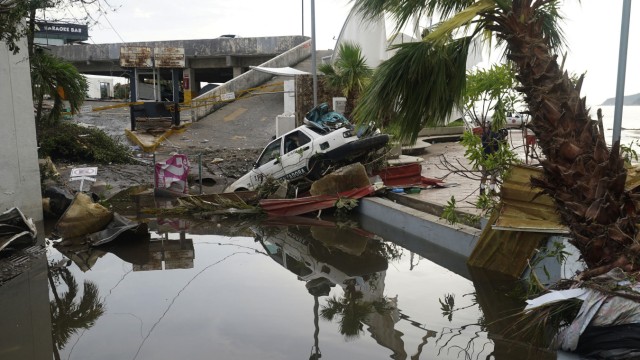Due to the devastating hurricane Otis At least 27 people died on the west coast of Mexico. Another four people are still missing, as Security Minister Rosa Icela Rodríguez announced. The tropical storm caused severe damage in the famous seaside resort of Acapulco. “It is a catastrophe what happened in Acapulco,” President Andrés Manuel López Obrador said in his daily press conference. The population is now to be supplied with food through, among other things, an airlift.
Otis hit the coast on Wednesday night as an extremely dangerous hurricane of the highest level 5 with sustained wind speeds of almost 270 kilometers per hour and gusts of up to 330 kilometers per hour. It then lost strength over land and finally dissipated.
On the way to the disaster area: President gets stuck
López Obrador traveled by car to Acapulco with several ministers on Wednesday to get an idea of the situation. The government delegation also repeatedly got stuck on its way due to landslides and flooded streets. After a meeting with representatives of emergency services, the armed forces and local authorities, the president flew back to Mexico City in a helicopter.
Mexican President Andres Manuel Lopez Obrador (third from left) and members of his cabinet had to wade through the mud on the way to the disaster area.
(Photo: Rodrigo Oropeza/AFP)
Have the greatest damage Otis in Acapulco, but other towns were also affected, said the president. “Not a single power pole was left standing in Acapulco,” he said. Security Minister Rodríguez spoke of “severe” damage. Hotel facades were torn down, windows were broken, trees fell and streets were flooded, according to the newspaper Milenio reported. According to the government, around 200 patients from a damaged hospital will be taken to other clinics. The highway between Acapulco and the capital Mexico City, around 480 kilometers away, was closed after landslides. The airport in the tourist resort ceased operations. According to media reports, over 100,000 vacationers were initially stranded.
Initially there was little information about the extent of the damage because the internet and telephone networks had collapsed. According to the state provider CFE, 500,000 households were temporarily without electricity. Otis also damaged the early warning system for earthquakes on Mexico’s Pacific coast. The operator said communication with at least 27 of the approximately 100 sensors in the seismic observation network was interrupted. If a strong earthquake occurs near the damaged sensors, the population cannot be warned in time.
Photos in the media showed, among other things, devastated stretches of coastline in the city. The lobby of a hotel was littered with debris, and a small car had been washed inside the hotel. The facade of the Galerías Diana shopping center was completely demolished on one side. Landslides and uprooted trees blocked roads and highways. In the village of Sabanillas, according to a report by “Milenio”, the houses and fields of dozens of families were destroyed.

A street littered with rubble in Acapulco.
(Photo: Marco Ugarte/dpa)
The local government set up emergency shelters, Guerrero state governor Evelyn Salgado Pineda said. According to the Ministry of Defense, around 8,400 soldiers were deployed to the region to help with recovery and clean-up work.
From tropical storm to dangerous hurricane
What was unusual was that Otis developed from a tropical storm to an extremely dangerous hurricane in just about twelve hours. According to experts, the rapid intensification of hurricanes is due to climate change. Because ocean surface temperatures are rising, hurricanes can not only absorb more water vapor, but also do so at an increasingly rapid rate.
The seaside resort of Acapulco is known for its cliff divers and luxury hotels. The international jet set once stayed there. However, due to the high level of violent crime, fewer and fewer tourists have recently come from abroad. Today, residents of Mexico City in particular spend their holidays or long weekends in the seaside resort.

